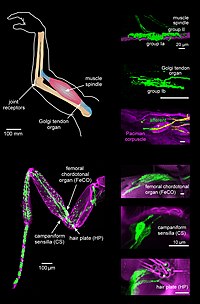
Photo from wikipedia
To maintain postural balance, the proprioceptive, vestibular, and visual systems continuously provide body position and movement data to the central nervous system. In this study, our main aim was to… Click to show full abstract
To maintain postural balance, the proprioceptive, vestibular, and visual systems continuously provide body position and movement data to the central nervous system. In this study, our main aim was to examine, for the first time, the influence of anaerobically or aerobically induced fatigue on these separate functions in persons with and without chronic ankle instability (CAI). We obtained assessments pre- and post-fatigue protocols from 60 physical education students (Mage = 24.3, SD = 3.4) Twenty-seven students had CAI, and 33 students did not have CAI). To measure proprioception, we used the AMEDA device; for vision, we used near point of convergence (NPC); and, for vestibular function, we used subjective visual vertical (SVV). We found a pre-post proprioception (AMEDA) effect in the aerobic group (p < .001), and a visual (NPC) effect in both anaerobic and aerobic participant groups (both p < .001). There were no visual system (NPC) fatigue effect differences among aerobic or anerobic participants who had or did not have CAI (p = .047); there was a significant aerobic fatigue effect on proprioception (AMEDA) (p = .010) that favored participants without CAI. There was a significant interaction effect between time of testing and CAI for visual (NPC) (p = .003) in the aerobic group only. In both the anaerobic and aerobic groups, post-fatigue vestibular function (AMEDA) was significantly lower for those with than those without CAI (anaerobic: p = .030; and aerobic: p =.016). Thus, post-fatigue, participants with CAI showed worse proprioceptive, visual, and vestibular function than those without CAI. Future investigators should further examine each movement sense system in individuals with CAI.
Journal Title: Perceptual and Motor Skills
Year Published: 2022
Link to full text (if available)
Share on Social Media: Sign Up to like & get
recommendations!